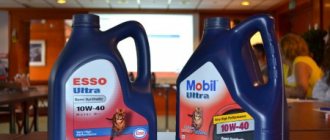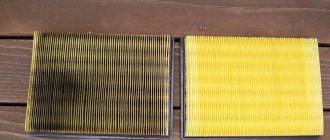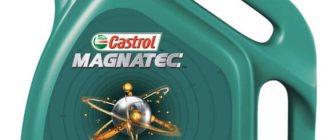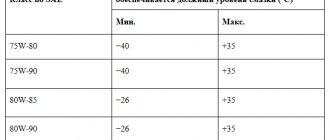Motor oil is designed to protect engine parts from wear and ensure smooth operation of mechanisms. Correctly selected lubricant can reduce fuel consumption. But how do you know that the motor fluid has exhausted its service life, lost its original properties, and requires replacement? Another aspect that has to be taken into account: the presence of counterfeit lubricants in retail outlets. Car enthusiasts inevitably have to study the signs of the originality of a product, because the use of counterfeit products entails serious consequences. Let's look at how to independently check engine oil for quality and authenticity.
Each type of lubricant has its own service life. After this time, the lubricant becomes unsuitable for use! The service life of the car oil is indicated on the label by the manufacturer (the replacement period is indicated by the mileage after which it is necessary to change the engine oil). But this period is considered conditional for the reason that it does not take into account operating conditions (for example, frequent downtime in city traffic jams with the engine running, and other nuances).
Is it normal or does it need replacing?
When starting a fluid test at home, follow these steps:
- warm up the engine;
- stop the power unit, allow the mixture to drain from the engine to the sump;
- take out the dipstick, drop some engine fluid onto a white napkin or sheet of paper;
- leave the napkin in a horizontal position for 2 hours (more is possible);
- determine the condition of the liquid by the oily stain left behind.
Figure 1. Oil slick
Having tested to check the quality of motor oil at home, we received the result shown in Figure 1.
Let's analyze the state of the tested mixture. To do this, we will select zones:
- 1 - core, let’s denote its diameter d1, mm;
- 2 - marginal zone of the core - d2, mm;
- 3 - dispersed zone, designated D, mm;
- 4 - zone of pure oil, not needed for calculations, may be absent during testing.
Let's calculate the diffusion area, which characterizes the dispersing abilities of motor fluid using the formula: Dc = 1- (d2)2/ D2. The resulting number must exceed 0.3 conventional units, otherwise the dispersing properties of the liquid are poor - the mixture must be replaced.
How to distinguish original oil from fake
Leading motor oil manufacturers are constantly improving ways to protect their products from counterfeiting. No wonder. There are unofficial statistics according to which about 40% of all motor oils sold on Russian markets are counterfeit products.
It will not necessarily be oil that is absolutely unsuitable for use. Often, canisters of well-known brands are filled with cheap mineral oil with a simple set of additives, which is far from the properties of the original, but is also suitable. But sometimes, instead of oil, you come across a substance that can damage the engine in a short time.
Let's look at several protective techniques implemented by leading manufacturers, and also tell you how to check engine oil for authenticity.
- Castrol . Laser engraving is applied to the cork and the protective ring, which acts as a kind of seal. It is impossible to open the canister without damaging the integrity of the engraving. Also, in garage conditions, it is quite difficult to fake such protection. There is a hologram with a code that can be sent via SMS to the manufacturer and receive a response about the authenticity of this oil.
- Shell. The cork has a hologram with a number that can be checked on the manufacturer’s official website, as well as a QR code for quick verification through the mobile application. The code on the hologram should change color when water hits it.
- ZIC . The oils of this famous Korean brand are protected by applying a special engraving to the label. This engraving is visible when the angle of incidence of light changes. It is almost impossible to fake it in artisanal conditions.
- Mobil . Authenticity is verified under ultraviolet light. The label completely absorbs ultraviolet rays. But the letter “o” in the oil name and the viscosity designation are highlighted.
- Lukoil . Domestic motor oil, oddly enough, is no worse protected than that of expensive imported manufacturers. The label is not glued to the canister, but is fused into the plastic during production. There is laser engraving and a serial number, which can be checked on the manufacturer's website.
Visual assessment
Not every car enthusiast will want to do calculations to assess the quality of a car oil. Therefore, taking a sample from the engine and receiving an oil slick, evaluate the condition of the liquid according to the criteria:
- The edges of the stain are smooth - the mixture has good washing properties, there is no water.
- The drop spread and formed several zones - the mixture is not old.
- The engine mixture is thick and does not spread - the fluid requires replacement.
- The presence of metal particles on the napkin means the internal parts in the engine are wearing out, the oil does not have good anti-wear properties.
- A brown or gray rim around the edges of the spot indicates insoluble particles formed during an oxidation reaction. The fluid needs to be replaced: with increasing mileage, the amount of impurities increases.
To make the task easier, let us point out: the oil shown in Figure 1 is satisfactory:
- has good dispersion properties: Dc=1-(d2)2/ D2=1-172/312=1-289/961=1-0.3=0.7 conventional units;
- has smooth edges;
- spread out, forming four zones.
It is better to replace the engine mixture - Figure 2.
Figure 2. Oil stain
When assessing the quality of motor oil at home, take as a standard the lubricant that was initially filled in, if you still have a canister of motor oil. Compare the mixture from the canister with the fluid extracted from the used engine.
Many car enthusiasts, before pouring the purchased mixture into the engine, pour a certain amount of new oil into a plastic cup and let it sit for two days without any impact. This method allows you to evaluate the quality of the motor fluid: a product that has separated into fractions should not be used to operate the engine.
An effective method for determining fluidity is to leave a little liquid in the cold in winter for 12 hours (winter or all-season oil), then check whether the liquid has begun to crystallize - fluidity is the main condition for starting the engine without warming up.
Summer classes of oils are heated in a container on the stove and see if the mixture will separate; if the liquid withstands the temperature test, it retains its structure - it can be used in the summer when the engine is heavily loaded and the temperature outside the car is high.
When purchasing motor oil, use the methods indicated to make sure that the mixture will protect the engine from premature wear. Remember, there are situations when the oil needs to be changed earlier than the scheduled change; you can find out about this by using the “oil spot” method.
Delamination
Any oil contains additive packages that improve its properties. In good oil, they last for years without falling out, which cannot be said about counterfeit products from an underground workshop. To assess the quality of impurities, some experts suggest pouring the test product into a glass flask and exposing it to the sun. After a few days, it may release chemicals in the form of sediment. If flakes appear, then this is a fake.
But microscopic particles are not always noticeable. Then you can take a sheet of white paper and spill a couple of drops of lubricating fluid, which will flow down and be absorbed into the paper. If clots appear along the way of the drop, then this is a sediment, which indicates the low quality of the oil.
Article on the topic
How to save money on spare parts. Advice from experts
Label analysis
Manufacturers of counterfeits forget to indicate information on the containers, without which the lubricant is not allowed into stores. Before purchasing a petroleum product, look on the Internet to see what the original container of any brand looks like.
The label must contain the following information:
- viscosity class determined according to SAE specification;
- engine type – gasoline/diesel;
- main liquid – synthetic, mineral water, semi-synthetic;
- ACEA and API markings;
- car manufacturer approvals.
There is no EAC (European Asian Community) quality mark on counterfeits
Please note the production date. The exact time and batch number must be written.
Drop test
For this method, a liquid sample is taken, a reference sample from the remaining oil in the canister.
- The sample is poured into a watering can with a neck diameter of 1 mm.
- The number of drops of new lubricant liquid falling in 1 minute is measured.
- The procedure is repeated with a sample from the crankcase of the power plant.
If the results differ by more than 10%, the lubricant must be urgently replaced.
Important! If the final test result is unsatisfactory, further use of the lubricant is prohibited.
What is the danger of using low-quality or counterfeit oil?
Motor lubrication plays a huge role in the proper and long-lasting operation of the engine. Moreover, modern oil is the end result of the work of many people. It is created in laboratory conditions, using advanced technologies at the molecular level. In an engine, the lubricating fluid not only forms a film on rubbing parts, but also removes excess heat, protects internal surfaces from corrosion and oxidation, and absorbs the resulting combustion products, water vapor, dust and various contaminants. The work takes place in extremely difficult conditions. It continuously circulates through the highways and cavities of the engine, providing the engine with thermal balance. Fake motor lubricant is made at home. It is based on a mixture of mineral and industrial oils. The use of such a dangerous mixture can lead to dire consequences:
- the oil pressure in the system may drop, but the driver will not notice this, since the warning light will not light up;
- engine parts will be subject to increased wear and corrosion, because the low-quality industrial base is not intended for use in automobile engines;
- in winter, due to low viscosity, the engine may not start.
We recommend: GDI engine – what is it and why is it good?
Frequent replacement encourages counterfeiting
The unique properties of the oil are given by a base consisting of a mineral, semi-synthetic or synthetic base and a set of special additives. The role of motor lubrication is so great that each type of engine produces its own grade, which takes into account the operating conditions of the power unit, the degree of its boost, the presence of a turbine, ambient temperature and other important characteristics.
The oil needs to be changed after 10,000 km.
Oil is a consumable material that is subject to periodic replacement in accordance with the technical regulations of the vehicle. High-quality motor oil cannot be cheap, since its production is technologically complex, costly, and responsible. There are not many companies in the world that constantly develop new varieties, test them, and launch them into production. All varieties have long been certified by international standards. In Russia, special GOSTs have been developed in this regard.
On the other hand, a high-quality product is easy to counterfeit. Nobody tastes it. Only the color, viscosity and brand of the manufacturer’s container are assessed. These characteristics are not so difficult to falsify, which is why there are many surrogates on the market. The costs of preparing counterfeits are small, and they are sold at a good profit. Their attractiveness lies in the fact that the price of counterfeits is set somewhat lower than for original high-quality oil.
Color as an indicator of the properties of motor oil - true or false?
The color of the oil indicates how worn it is. Myth or truth? Should you change the oil as soon as it has lost its color? There are cars in which the oil changes color and transparency after 2-3 thousand km after changing it. In other cars, even after 15 thousand km, the oil is still amber-transparent. So what does the color of the motor oil used say? Is it possible to tell when it's time to change it by color?
- Did you know that recycled motor oil can be sent to a laboratory to determine the condition of your car's engine?
- Using a chemical test, you can also find out exactly when motor oil loses its protective properties. This allows you to find out exactly at what mileage to change the engine oil. An express test, as a rule, does not allow you to find out.
- The best thing we can do for our car's engine is to change the oil in a timely manner.
Used oil in a diesel engine looks different than oil in a gasoline engine. In the first case, the oil is usually black, in the second it is optional. In some gasoline engines running on gas, the oil practically does not turn black, that is, when you drain the used oil in such engines, you can see that it looks almost like new.
Motor oil is regularly heated to temperatures in excess of 100°C and "machined". All this causes a shift in its molecules. As a result, the oil changes its properties and parameters. But unfortunately, we cannot say anything by eye about the condition of the oil, since we cannot see how the formula of the molecules in the waste liquid has changed.
It is much easier to see what foreign substances have entered the oil. First of all, we are talking about fuel. The fuel enters the oil pan, flowing down the walls of the engine cylinders. The amount of fuel flowing down the cylinder walls increases when starting a cold engine. In the case of diesel engines, this occurs during regeneration of the diesel particulate filter. Under extremely unfavorable conditions, it is even possible to observe an increased oil level in the engine (oil-fuel mixture), despite the fact that a certain amount of oil is constantly being burned in the engine.
Solid particles also get into the oil: most of them (by volume) get into diesel engines and much less into gasoline engines. But the least amount of particulate matter gets into gasoline engines that run on gas. This is why the oil in diesel engines darkens very quickly, in gasoline engines - more slowly, and in some cars running on liquefied gas, it practically does not change its color.
See also: Here's why the oil pressure light on your dashboard won't save you from engine damage when your oil level is low
A small amount of solid particles in the oil does not mean that the liquid has not lost its properties. Quite the contrary. For example, in cars running on gas, despite the fact that the oil practically does not change its color, the liquid is subject to rapid degradation. This is due to acidic compounds formed during the combustion of gas in the combustion chamber of the engine: some of the acids leave the engine through the exhaust pipe, and some go into the oil. That's why some car manufacturers that equip some models with a gas-powered system from the factory require car owners to change their oil more frequently than non-gas-powered cars.
In addition, regardless of the type of fuel used in internal combustion engines, as a result of fuel combustion, products are always formed that also end up in the oil. Plus, by-products can form in the oil itself due to physical and chemical processes. A small amount of products formed during fuel combustion leaves the combustion chamber, burning along with the fuel. Some of the gases return to the engine crankcase. Moreover, the more worn out the engine is, the more various by-products are formed in it.
See also: Formula 1 engines burn motor oil to increase power
Did you know that you can take a sample of used oil from an engine and have it analyzed in a laboratory to determine what condition the car's engine is in (you can at least assess the condition of the engine liners)? Unfortunately, such laboratory analysis is expensive and does not always give a clear answer. In some cases, this test makes sense. But it is better to change the oil and oil filter more often.
There are also disposable oil testers on sale today, which (in theory) allow you to reliably assess the condition of the engine oil: determine whether it needs to be replaced. Typically, such one-time tests look like this: we take a drop of oil from the engine, apply it to an express strip and wait 10-30 minutes, after which we determine the degree of wear from the oil trace, comparing the trace with the template.
However, in practice, everything is not so simple: from the test strips you can easily notice that the oil you are using contains many foreign substances that are not present in the new oil. But nothing more. In general, this test is still similar to fortune telling on coffee grounds: oil stains indicate something, but it is not entirely clear what exactly it is about. Data indicating, for example, the condition of the engine is out of the question.
With a rapid test, however, you can easily tell whether the oil quickly loses its properties after changing. In addition, using an express oil condition test, you can experimentally find out when, after replacement, the oil begins to lose its properties. This may help to figure out when to change your oil.
Last year, a video appeared on the Internet where the authors demonstrated an unusual oil test: testing the fluidity of various oils on an inclined surface (for example, the test can be carried out on glass). So, if you drop new oil onto an inclined surface, its fluidity will be slightly different compared to the oil already used in the engine.
If you do a similar test with used oil (same viscosity and grade and temperature), you will see that the used oil flows down the plate at a different rate. This means that the viscosity of the oil used has changed. That is why when purchasing motor oil you need to pay attention to the viscosity grade. After all, the car owner must be sure that the oil really protects the car engine and has the correct parameters.
Many drivers like to rack their brains, constantly searching for the grail that would maximize engine life. But, unfortunately, most advice and opinions are a myth. The best thing we can do for our car's engine is to change the oil regularly. At least once a year and at least every 10,000 km.
And don't listen to dealers who say that your car needs an oil change every 15,000 km. For most even modern engines, an interval of 10 thousand km is the most suitable. Ideally, of course, if you use your car in the city (often driving short distances in winter), it is better to change the oil even more often. The fact is that city driving refers to difficult operating conditions of the car. Accordingly, the oil should be changed much more often than the manufacturer recommends.
The more often you change your oil, the better your engine will be. In this case, harmful impurities accumulate in it more slowly, which over time begin to settle on various elements of the motor.
Method of dripping onto a sheet of paper
First, the lubricant is heated to the operating temperature of the power plant. Then, using a syringe or other tool, the motor oil is taken from the dipstick. Before the operation, a standardized sheet of paper with a density of 80 grams per square meter is laid out on the technical table. Next, drop oil onto it and wait for the drops to “spread” across the paper. Half a day or 24 hours are allotted for this.
During this time, the droplet sample, spreading in a circle, forms rings on the sheet. This is internal and external. To calculate, use the formula DSS=1 - d2 / D2. We divide the chromatogram core by the diffusion outer diameter. The result will be a value of 0.3. It should not be less than this numerical value.
Service interval and need for oil flushing
On modern engines, it is necessary to change the oil every 8-10 thousand kilometers, depending on the condition of the engine. Previously, you could drive a car for 20,000 kilometers and only then change the oil. Today, engines operate under greater load, most of them have additional turbines, which also leads to rapid wear of the oil and loss of its original characteristics. Therefore, if possible, the service interval should be reduced as much as possible; this slightly increases the car owner’s maintenance costs, but at the same time eliminates the need for early major engine repairs.
04.06.2021
Checking the quality of engine oil: what a car owner needs to know
Most car enthusiasts are well aware that the quality and condition of the engine oil directly affects the serviceability of the engine and the service life of the power unit before major repairs. For this reason, it is necessary to use only types of oils recommended by the vehicle manufacturer, taking into account a number of important parameters (base stock, viscosity at high and low temperatures, SAE and ACEA tolerances).
In parallel with this, you also need to make allowances for the individual operating conditions of the vehicle, as well as regularly change the oil and oil filter. As for changing the oil, this operation must be performed correctly (completely draining the old lubricant, flushing the engine when switching to a different type of oil, etc.).
In this article we will talk about how to check the lubricant after filling it into the oil system, as well as what signs and how to determine the condition of the oil in the engine of a gasoline or diesel car.
Motor oil quality tester: guesswork or truth?
A template for an express test for checking engine oil, which the test manufacturer uses to compare a sample of the engine lubricant used
These tests were carried out using special disposable testers, which are tissue paper, onto which a drop of oil is applied. Next, according to the instructions for the test, a time of about 40 minutes was maintained and the samples were compared according to the template provided by the manufacturer of the tests for motor oil. Unfortunately, using the templates provided, it was difficult for technicians to assess whether the oil was still normal or whether it had become so bad that it could no longer be used in the engine.
So we do not advise you to purchase similar engine oil check tests, since they are not informative. The only thing that can be determined by these tests is when the oil begins to lose its properties and accumulate various impurities. But to do this, you must conduct tests experimentally, comparing the oil at different vehicle mileages. This way you can learn approximately when it is ideal for your car to change its oil. But again, this is all approximate. Reliable analysis is really only available in the laboratory.
See also: 74 Maintenance Tips That Will Extend the Life of Your Car
So it’s easier not to fool around and not bother yourself, but to change the oil much more often than the car manufacturer advises. Especially if you drive your car mainly in the city or most often only drive short distances.











